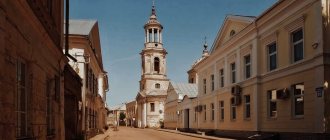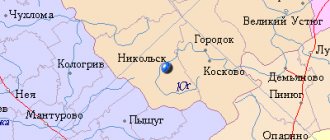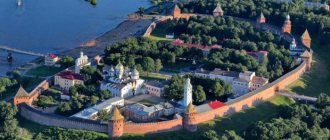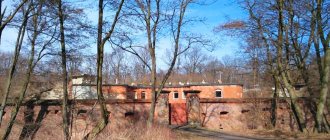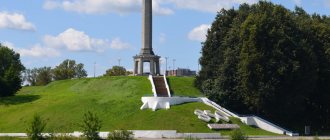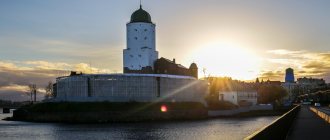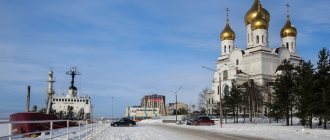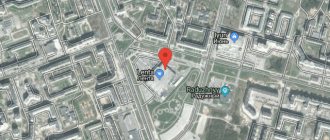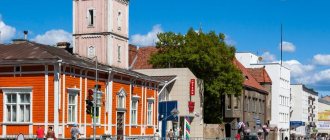| Porkhov |
Porkhov
, a city in Russia, the administrative center of the Porkhov district of the Pskov region, the second cathedral city of the Pskov diocese. Located in the Shelonskaya lowland, on the river. Shelon (the basin of Lake Ilmen), 3 km from the railway station of the same name on the Bologoe-Pskov line, 88 km east of the regional center. Population - 8.9 thousand people. (2017).
- On the map: Yandex.Map, Google map
The city was founded in 1239 by the noble prince Alexander Yaroslavich (in the future - Nevsky) when creating a system of fortresses on the Shelon River along the border of the Novgorod land. The fortifications had the appearance of an irregular pentagon, repeating the contours of the hill they occupied. The name of the city is derived from the noun porkh
("gunpowder") or the personal name
Porkh
. The town became a key defense point on the borders with the Principality of Lithuania. In 1346, the city withstood a siege by the troops of the Lithuanian prince Olgerd.
The original wood-earth fortress was destroyed by fire and in 1387, at a city meeting, the Novgorodians decided to move the fortress to a new location. On the western side, the approaches were covered by the bed of the Sheloni River, on the east by a wide ditch, and on the north the fortress was adjacent to a swampy lowland, impassable in rainy times. A new city center was formed in the new stone fortress. In 1428, the city again withstood the siege of the Lithuanian troops of Prince Vytautas. In 1430, the city fortress was reconstructed.
In 1478, along with the entire Novgorod land, Porkhov became part of the Moscow state and became a grand-ducal fiefdom. At that time it was considered one of the 12 most reliable fortresses of the Russian land. In 1581, the city was besieged by the Polish troops of Stefan Batory. During troubled times, in 1611-1617, the fortress was captured by the Swedes.
Since 1708, Porkhovsky district became part of the Ingermanland (since 1710 - St. Petersburg) province. Since 1719 - as part of the Novgorod province (since 1727 - in the Novgorod province of the Novgorod province). In 1777 it was designated a district town of the Pskov governorship (since 1796 - Pskov province). Since the 18th century, it has been a famous flax trading center.
On August 1, 1927, the Porkhovsky district with its center in Porkhov was formed as part of the Pskov district of the Leningrad region. During the Great Patriotic War, the city was occupied by Nazi troops from July 11, 1941 to February 26, 1944. The occupiers set up a concentration camp “Dulag-100” near Porkhov. Before the retreat of fascist troops from the city, over 90% of its buildings were blown up.
Since August 23, 1944, Porkhov has been the regional center of the Pskov region. In October 1959, the abolished Slavkovsky district and the southern part of the abolished Pavsky district were transferred to the Porkhovsky district. During the post-war reconstruction, the city largely lost its pre-war appearance. At the same time, the perimeters of the walls of the 14th century have been preserved in the old fortress; Small, Middle and Nikolskaya towers; the remains of a moat and the St. Nicholas Church, erected on the site of the old St. Nicholas Church near the tower of the same name in the 18th century. At the beginning of the 21st century, a lime and cheese-making factories, a forestry enterprise, and a pig-breeding complex operated in Porkhov; there were two secondary schools, a speech boarding school, a branch of the Dedovichi Agricultural College, a children's art school, a social shelter, an interdistrict hospital, a central district hospital, a House of Culture, a stadium, a local history museum, a cinema, a House of Crafts, an evening school, a Children's Creativity Center, a printing house and editorial office of the newspaper "Porkhovsky Vestnik".
Statistics
- 1856 - 5.9 thousand people, 7 churches, 571 houses, 74 shops
- 1897 - 5.6 thousand people
- 1926 - 8 thousand people
- 1959 - 7.6 thousand people
- 1979 - 13.4 thousand people
- 1992 - 14.4 thousand people
- 2010 - 11.1 thousand people
Porkhov Museum of Local Lore
So, we present to you the ancient Porkhov, attractions, photos with descriptions, videos, and also invite you to visit Pskov with it.
Any visit to Porkhov - planned or spontaneous - should start with the local history museum if you are interested in a description of the history of the region. Today the Porkhov Museum includes several stationary objects:
- House of Crafts.
- The first museum building on the territory of the fortress.
- The second building of the museum.
- Exhibition "Museum of Postal Service".
- Showroom.
The museum conducts master classes on introducing and teaching folk crafts: weaving and weaving. You can independently explore the displays and exhibitions in all departments, or book a tour. But the best option is, nevertheless, a trip to Porkhov with “Charm Travel”, during which you will be accompanied by professional guides, and you will learn the history of the town in the best and most interesting presentation.
In the museum you can not only see antiques, household utensils and furniture, but also hear the sounds of a real gramophone
Porkhov Fortress
The Porkhov Fortress (Pskov Region) occupies the central part of the city and rises on the high bank of the Shelon River.
The date of its foundation is considered to be 1239, and the initiator of construction is Alexander Nevsky
The stronghold was erected to strengthen the waterways of Rus', as well as to repel the claims of warlike neighbors.
Now the fortress is the most famous landmark of Porkhov. With the exception of a few sections, its fortress walls have been preserved almost along its entire length. Having examined it, you can imagine how well fortified and powerful it was in its time. In addition to the fortress walls themselves, the stronghold was surrounded by high – up to 4 meters – ramparts and deep ditches along the perimeter.
What else is worth seeing in Porkhov
Social and cultural complex
- Address: Lenina, 14a.
The main cultural and entertainment life of the town takes place in the Porkhov Social and Cultural Complex. All the main festive and special events of the city are held at this site. Leisure activities for residents and tourists are also organized here - film screenings and concert programs.
Shelon River
This river flows through the territory of the Pskov and Novgorod regions. Near Porkhov its current is fast and rapids, the banks are high, covered with willow and alder. Further on, where the coasts are flatter, there are beaches and swimming areas. In the lower reaches the Shelon River is navigable and flows into the famous Ilmen Lake.
St. Nicholas Church
The city of Porkhov, whose sights are in every tourist guide, can be proud of them. One of the most interesting monuments is the ancient St. Nicholas Church from the 15th century. It is located on the territory of the fortress, and when you come for a walk around the town, you will certainly see a monument of ancient architecture.
The church was rebuilt more than once: first, a new building made of limestone slab was built on the old foundation, and in the 19th century the bell tower on the temple was “kicked out”
It is known that it was in the St. Nicholas Church that relics were kept, the importance of which for the city is difficult to overestimate: a cross with the relics of the Kiev Pechersk saints and the icon of St. Nicholas. After 1917, the cross disappeared without a trace, and the icon can be seen in the Pskov Museum.
Monuments and memorials
Monument to Alexander Nevsky
- Address: Lenin Avenue.
In 1989, in honor of the 750th anniversary of the founding of Porkhov, a monument to A. Nevsky, the city founder, was erected. It is a high pedestal crowned by a bust of the founding prince. Behind the composition is the Porkhov Fortress, as a reminder that it was on the orders of the Grand Duke that its construction began and, as a consequence, the emergence of the city of Porkhov.
Memorial complex "Dulag-100"
The opening of “Dulaga-100” took place on June 18, 2016 on the site of a building that was located here from 1941 to 1944. transit concentration camp. According to post-war estimates, more than 85 thousand people died there - prisoners of war and civilians.
The huge monument made of stone and iron fittings makes a heavy impression, but this is the history of the country and the memory of the people. Its complex includes the Chapel of the Intercession of the Mother of God and the Worship Cross. Here, in memory of the victims of the fascist regime, you can ring the alarm by going up to the memorial.
Monument to the Partisans
- Address: Porkhovsky Park.
The monument to the partisans was erected and opened in PKiO in 1975 in the Pskov region. During the war, partisan detachments operated and made a great contribution to the liberation of the city from the occupation of Nazi troops.
It is a known fact that on November 13, 1943, as a result of an explosion in a cinema during a film showing, which was carried out by partisan K.A. Chekhovich, 750 enemies died. This monument is a tribute to the memory of heroes from grateful descendants.
Monument to B.P. Kalachev
- Address: Porkhov Kremlin.
B.P. Kalachev was the leader of an underground group in the city that helped partisans and prisoners of war escaping from a concentration camp. In 1943, the underground members were discovered by the enemy, and Boris Petrovich ended up in prison, where he committed suicide without betraying any of his comrades under torture. A monument to him was unveiled in the Porkhov Kremlin in 2010.
Memorial Military Glory
- Address - pl. Red Army.
In honor of the soldiers who liberated the city of Porkhov from the German occupation, this memorial complex was opened in 1977 on Red Army Square. It is made in the form of a warrior calling for an attack and holding a weapon in his right hand, and a battle banner in his left.
Memorial to the Heroes of the People's War
- Address: Lenin Ave.
Where the Trinity Cathedral used to stand, destroyed in 1960, since 1974 there has been a Memorial to the Heroes of the People's War. It is dedicated to all the victims of the upheavals that occurred in the last century - the Revolution, the Civil and Great Patriotic Wars. This is evidenced by two bas-reliefs with the years indicated on them.
Noble estates
In the Pskov region there are two dozen ancient noble estates, the historical value of which is difficult to overestimate. And 10 architectural monuments are located in the Porkhovsky district. So, if you are planning a trip to Porkhov, make a note of visiting the two most famous noble “nests”:
- Stroganov estates.
- Estates of the princes Gagarins. (“Kholomki”).
It is sad that in the summer of 2022, one of the estates - in Volyshevo - was damaged as a result of a strong fire
In the future, excursions around the former property of the Vasilchikovs-Stroganovs will resume, but at present a full tour of the sights is impossible.
As for the estate of the princes Gagarins, the famous “Kholomki”, it is in very good condition, and you can take a walk in the park adjacent to the house, see the surrounding area, evaluate the condition of the interior, and admire the well-chosen location.
Nikandrova Holy Annunciation Hermitage
What to see in Porkhov in 1 day? Of course, the monastery in the Nikandrova Holy Annunciation Hermitage, which was restored over many years. You won’t see ancient architecture there, but the way the cells, utility rooms and cathedral look today deserves attention.
Nikandrova Pustyn is a place of prayer, known for its strong healing energy and multiple healings.
People come here to be away from the bustle of the world, think about the eternal, pray, drink holy water and take it with them. On the territory of the Nikandrova Desert there are several springs with life-giving water:
- Petropavlovsky.
- Icons of the Kazan Mother of God.
- Nikandrovsky.
- Life-giving cross.
- Ave. Alexander Svirsky.
Each of them has special properties, which you can learn about by taking an excursion to the Nikandrova Desert with Sharm Travel.
Church of the Transfiguration
The church was originally built from stone slabs. From the 15th century until 1764 there was a monastery here, which was abolished by the will of the reigning empress. In the second half of the 18th century, the church building was completely rebuilt with funds from the private fund of Major General P. M. Panteleev. Today the temple is a typical example of provincial baroque.
After 1990, the church was renovated and today services are held there.
If you are attracted by an impressive list of Porkhov sights with photos and videos, book a tour with Sharm Travel and you will see not only its architectural and historical monuments, but also the Pskov Kremlin and other ancient towers and fortresses of Rus'.
PORKHOV
PORKHOV, a city in Russia, in the Pskov region, the center of the Porkhov district. Us. 9.6 thousand people (2014). Located on the river. Shelon. Railway station. The Pskov – Soltsy (Novgorod region) – Veliky Novgorod highway passes through P.
Porkhov. The fortress wall with the Nikolskaya bell tower and the Nikolskaya Church (1770, on the foundations of 1412) in the fortress. Photo 2012. Photo by A. P. Pyatnov
Photo by P. S. Pavlinov Porkhov. Church of the Nativity of the Virgin. Presumably 15th century. (southern aisle and bell tower, 18th century). Photo 2013.
Founded in 1239 by Prince of Novgorod. Alexander Yaroslavich as “the town on Shelon”. The original fortification (the old Porkhov settlement on the “Polyakovaya Manor”) was erected on a cape formed by the river. Shelon and the river flowing into it. Dubenka, on the floor side, was surrounded by two rows of ramparts and ditches. Archaeological Excavations have established that Ch. the rampart of the fort was filled three times (between 1239 and 1300, ca. 1300, between 1300 and 1387), in the 14th century. its height reached 4.3 m, along its top there was a tree consisting of log towns. wall. In 1346, the townspeople of Petrograd paid off the Lithuanian troops that besieged the fortress. book Olgerda. In 1387, due to tense military-political tensions. Due to the situation on the borders of the Novgorod Republic, the Novgorodians moved P. 1.3 km from the old settlement, to an island washed by the river. Shelon (in the 18th–19th centuries, the Shelon channels to the east of the fortress were filled with construction debris), where at hand. the boyars Ivan Fedorovich and Fatyan Esifovich built a stone fortress in the form of an irregular pentagon with walls approx. 500 m, thickness up to 2.3 m and height. up to 11 m (preserved up to 9 m), with 3 towers high. up to 17 m - square Malaya (5 tiers), semicircular Middle (6 tiers) and rectangular Nikolskaya (6 tiers; a bell tower was built on at the beginning of the 19th century), 2 zahabs (fortifications to protect the entrance gates) - Nikolsky (main entrance) and Pskovsky, 2 secret passages to the water. In 1428 P. withstood the siege of the troops led. book Lithuanian Vitovt. In 1430 the fortress was reconstructed. In the 1440s The Pskov Tower (6 tiers; finally destroyed in 1876) was built as part of the Pskov Zahab. Archaeological Excavations in the fortress showed that in the 14th–15th centuries. it did not have developed residential development; probably only representatives of the privileged lived in it. layers of townspeople. Extensive settlement of P., according to archaeological According to data, it extended on the right bank of the Shelon from the old settlement (the most ancient part of the settlement) to the stone fortress, and on the left bank it reached the Spaso-Preobrazhensky Men's (first mentioned in 1399, closed in 1917) and Rozhdestvensky Women (founded no later than the 16th century, closed in 1764) monasteries. From the end 15th century P. was part of the Shelonskaya Pyatina of the Novgorod land. In 1581, during the Livonian War of 1558–83, it withstood the siege of the Polish-Litovs. troops. During the Time of Troubles in 1611, during the Swedish intervention of the early 17th century, the Swedes came under control. troops. According to the Stolbovsky Treaty, 1617 remained part of the Russian Federation. state In 1708–27 it was part of St. Petersburg. lips (until 1710 Ingermanland province), in 1727–1776 - to Novgorod province. District city of Novgorod (1773–76), Pskov (1776–1927; in 1777–96 Pskov governorship) provinces. In 1897, permanent railway traffic was opened. line Bologoe - Pskov, passing through Porkhov.
Sov. power installed on Nov. 1917. In 1919, during the Civil. war of 1917–22, near Petrograd, units of the Red Army stopped and defeated the detachments of S. N. Bulak-Balakhovich. District center Leningr. region (1927–44), from 1944 Pskov region. In Vel. Otech. Germany was occupied during the war. troops 11.7.1941. In P., mass executions were carried out in the field near the Old Settlement (over 5 thousand people), in the Dulag-110 camp in Aug. 1941 – Feb. 1944 died approx. 85 thousand owls soldiers and officers, in a camp near the village. Zapolyanye (near P.) – St. 3 thousand partisans, underground fighters and civilians. In Petrograd there was an underground movement, numbering St. 600 people, led by B.P. Kalachev. During the retreat of the Germans. troops blew up St. 90% of the city's buildings. Liberated by Red Army units on 2/26/1944 during the Leningrad-Novgorod offensive. operations.
The city center was built in accordance with the master plans of 1772 and 1781. The main street is Peterburgskaya (along the left bank of the Shelon), Smolenskaya street. continued it to the south. direction. The oldest monument of P. is the fortress (restored in 1912 and 1962–68). In the fortress there is a single-domed, 4-pillar Nikolskaya Church. (1770, on the foundations of a Novgorod-type temple 1412). In the beginning. 19th century There is a bell tower on the Nikolskaya Tower. Opposite the old settlement on the banks of the Shelon - c. Nativity of the Virgin Mary (presumably 15th century, southern aisle and bell tower 18th century) former. Rozhdestvensky Mon. Near her - c. Transfiguration of the Savior “on Kostreh” (1772, on the foundation of a 16th century church) former. Spaso-Preobrazhensky Monastery At the entrance to the city from Pskov - ts. Nativity of John the Baptist at St. John's Cemetery (1804). Among other monuments are the buildings of the religious school (1882), the house and bank of the merchant Zatsky (1903; now the post office building). In the 1950s built: House of Soviets, fire station (1958). Monuments: “Partisan Glory” (1975; sculptor N. E. Klevets); “To the Soldiers-Liberators” (1977; sculptors N.V. Radchenko, B.M. Sergeev, B.S. Chebunin), Alexander Nevsky (1989), B.P. Kalachev (2010) and others. Local historian. museum (1919, collection destroyed during the Great Patriotic War; founded again in 1946, since 1980 a branch of the Pskov State United Historical, Architectural and Art Museum-Reserve) includes an exhibition hall (1993), House of Crafts (1998), expositions “Porkhov region during the war” (in the house of B.P. Kalachev on the territory of the fortress) (1986) and “Museum mail” (2009).
Relay and lime factories, woodworking enterprises. Butter and cheese plant, etc.
10 km west of P. there is a balneological center. Khilovo resort (founded in 1865 by local landowner P.P. Balavinsky; main natural healing factors: mineral water and medicinal silt mud, used to treat patients with diseases of the musculoskeletal system, digestive organs and nervous system). 12 km southwest of P. is the “Krasukha” memorial with the monument “The Mourning Pskov Woman” (1968; sculptor A.P. Usachenko) on the site where 283 residents of the village were burned alive in 1943. Krasukha. 15 km southeast of Porkhov on the bank of the river. Shelon – estate of Prince. A.G. Gagarin (from the Gagarin family) Kholomki (since 2000 Educational and historical reserve “A.G. Gagarin’s estate “Kholomki”” St. Petersburg Polytechnic University): Ch. house in the neoclassical style (1913–14, project by architect I. A. Fomin), park. 18 km southeast of P., in the village. Volyshevo, - the estate of the Vasilchikovs and Counts Stroganovs - is the largest estate complex on the territory of modern times. Pskov region (there were over 70 buildings, by the 2010s the majority were in ruins), including Ch. house (late 19th – early 20th centuries, architect K.K. Schmidt), c. All-Merciful Savior (1820), ensemble of a stud farm (19th century), extensive landscape park. 20 km west of P. - Nikandrova Holy Annunciation Hermitage (founded in the 3rd quarter of the 16th century, closed in 1928, in the 1920–1930s all buildings were practically destroyed, revived in 2001): village. churches in honor of the icon of the Mother of God “Seeking the Lost” (2002) and in the name of the Holy Royal Martyrs (2004–2007), brick Cathedral of the Annunciation of the Blessed Virgin Mary (2006–10). 23 km northeast of P., in the village. Opoki, - Annunciation Church. (1772) in Baroque style with carved wood. iconostasis of the 18th century. (simultaneous with the construction of the temple). On the right bank of the river. Shelon, near the village. Zapolye - settlement of the 2nd floor. 1st millennium and 13th–15th centuries. (area 45×85 m) – remains of the Middle Ages. the city of Opoki, which existed as part of the Novgorod Republic (founded, probably, in 1239, first mentioned in 1329/30 in the First Novgorod Chronicle, from the late 15th century there was a churchyard); near the settlement there are the remains of the stone St. Nicholas Church (late 13th – early 14th centuries).
